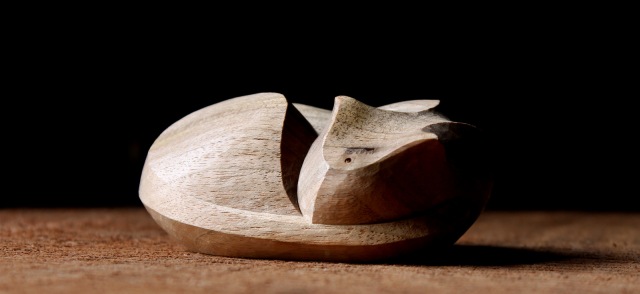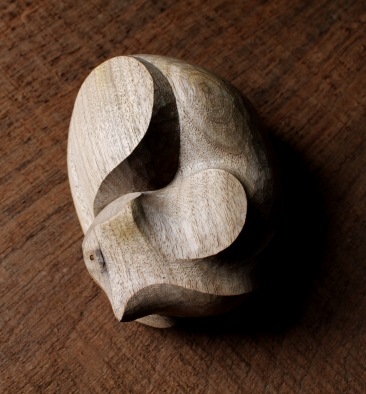
You can learn a lot by watching cats. They are studies in elegant movement and sinuous lines.
Our cat, Mavis (named after a Thomas-the-Train engine), is sixteen years old. Quick sketches of him appear here and there through my sketchbooks. He always seems to be in a good pose that creates a miniature landscape of curves. I suppose their natural fascination as subjects is one of the reasons cats appear in the art of many cultures going back to the earliest civilizations and that they continue to be popular models.

Mavis doing his best “Sphinx” pose.

Buttternut cat viewed from above.
As a gift for my daughter, I carved a small representation of Mavis (or any cat) curled up sleeping. I tried to simplify the form and translate it into a combination of curving lines and surfaces — a sculptural form much like a carved bowl or spoon.
At four inches long, this piece was sized well for holding in a hand while carving. I used many of the same knife grasps that I use for spoon carving. Most of the carving of this piece of butternut was done with a sloyd knife and pocket knife, and the surface is left directly from the knife cuts. No oil had been applied yet when the photos were taken.
Just as with a spoon or a bowl, distinct facets catch the light or hold shadows. And the effect changes when the piece is seen from different viewpoints.

It seems to me that automobile designers consider these same things, putting a lot of thought into the lines formed where two surfaces meet and the effect of light. Engines and horsepower aren’t really my thing, but I’ve always loved the image of the designer scraping away the clay from the car model, checking the surface with hand and eye. A process that continues today as you can see in this short video.
I find it interesting how the tapeline is established on one surface as the important junction, then the adjoining surface is faired by judgement to the line. I suspect that Charles Douglas carves spoons and bowls.
Anyway, this little diversion got me thinking, and, like every project, taught me a thing or two. Mavis, by the way, couldn’t care less.


Fun! My cat Jimmy loves it that I’m in the shop carving more, now that school is officially finished. He could care less that carving knives are not meant for cat scratching. Hope you all had a very Merry Christmas Dave, say hello, and enjoy a terrific New Year!
Emil
LikeLike
Congrats on finishing school, Emil. Merry Christmas and Happy New Year to all in your growing household, including Jimmy!
LikeLike
David, what a fantastic study of your cat! You have all the lines there to represent his (her?) essence but nothing extraneous. So very catlike, both in shape and personality–a critter who captures the very essence of life without anything extraneous and thus manages to sleep for 20 hours a day.
Your comparison of carving your cat to car-model shaping also holds true for classic boat design of the past, in which the designer would first carve a half-model from pine or cedar in order to establish hull shape. An example of this was Nathaniel Herreshof, a famous, blind Rhode Island boat designer and builder, the “Wizard of Bristol,” who could tell the fairness of either his model or full-sized boat by running his hand over it. His boats are legendary.
My late father, an architect and artist, told me that a well-designed carving should be able to be rolled down the stairs without breaking apart. I’m not sure if this was his original thought, or why he thought it, but your cat would fit into this category. Of course, that leaves out a lot of really famous carvings, such as by Michelangelo, who’s appendages would certainly fall off if you rolled them down the stairs.
Thank you for sharing your beautiful cat!
LikeLike
John, Thank you very much for your insightful comments. Great connection to boat design. I’m curious to read up on Nathaniel Herreshof. I don’t know if all of my carvings would stand up to your father’s test, but it’s an interesting thought! I’ve never heard that before, so maybe it was indeed something he came up with. I would love to see some of his work.
Oh…our cat is a male even though our kids named him Mavis. Sort of a “Boy Named Sue” thing!
LikeLike
Dave, I don’t know where he came up with his test, either. He worked as an architect but studied art and was mainly a painter after he retired. I don’t think many of my carvings would stand up to his test, either, but I love the compactness and “catness” of your Mavis. You’ve gotten me inspired to start in on carving again! On with the search of the elusive Gransfors Bruks adze…. A happy New Year to you!
LikeLiked by 1 person
“Mavis, by the way, couldn’t care less.” Yup that’s a cat response fo sure. However, a people response is that it’s well done as always and Happy 2019–
LikeLike
Thanks, Marie. Wishing many birds may fly your way in 2019.
LikeLike
Fabulous!
LikeLiked by 1 person
Very nice. What a lovely gift for your daughter that she will always cherish. I don’t know if you ever watched How to Train Your Dragon. The lead dragon Toothless has always reminded me of a cat.
LikeLike
Thanks, Joe. Great observation regarding Toothless.
LikeLike
I really enjoy your wandering mind. I learned something new today about car design. Thanks!
LikeLike
It definitely wanders! Thanks, Cindy.
LikeLike
Dave, I’m curious about the shape of the blank you started with as well as any initial markings you made before your first cut? Beautiful lines.
LikeLike
Basically, I just started by squaring up a chunk and drawing a rough idea of the cat with the basic positioning of the head and hind leg and the curl of the back on the upper surface, Chris. I didn’t really make a pattern or even a preliminary sketch of the specific design because I wasn’t sure where I was headed with it. Like often happens, the thoughts and possibilities sort of emerged as I was carving.
LikeLike